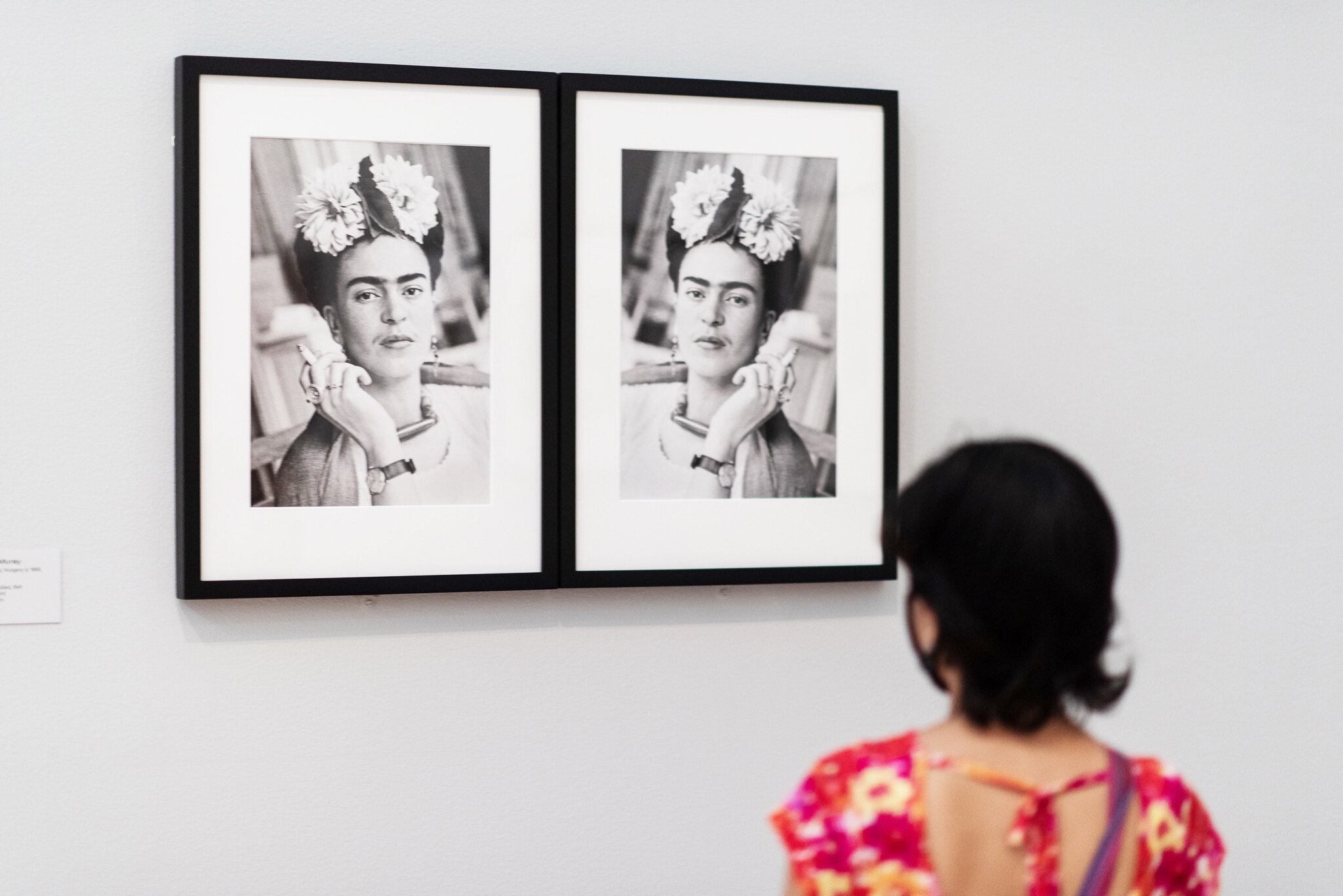An installation view of Frida Kahlo: POSE, on view through December 19 at the Rose Art Museum on the Brandeis University campus. Photo by Mel Taing/courtesy of Rose Art Museum
Two exhibitions at Brandeis University’s Rose Art Museum, “Frida Kahlo: POSE,” and “re: collections”—a broad selection of its striking contemporary art collection—welcome visitors back to the Waltham campus museum, which reopened in May.
The Rose has collected only contemporary art since its founding in 1961. From the beginning, prescient curators and collectors gifted de Koonings, Kusamas, Rauschenbergs, Warhols, Shermans and other 20th (and now 21st) century artists to the museum.
Recently donated works of Jenny Holzer, Nam June Paik, Betye Sair and others—86 in all—have bolstered that collection in significant ways. Not least of which, after a threatened closure of the museum and sale of its art during financial troubles in 2009, the gifts signal a renewed confidence in the museum’s viability.
The expanse of “re: collections: Six Decades at the Rose Art Museum” impresses in many ways. Occupying the main floor and almost all the lower gallery space, visitors are arrested by mesmerizing videos, photographs, paintings, sculpture and films.
But the sharpened focus of a small adjoining exhibition, “Frida Kahlo: POSE,” highlights some real possibilities for the future of the Rose.
“Frida Kahlo: POSE” is organized by the museum’s director and chief curator, Gannit Ankori. Ankori created thematic categories from Kahlo’s own work and the works (mostly photographs) of others, exploring Kahlo’s complex dedication to self-presentation.
As Ankori flatly points out in the exhibition labeling, Kahlo was a pioneer in fashioning the disabled body. Stricken with polio herself at six, and hit by a bus and gravely injured when she was 18, Kahlo spent her life in pain, adapting to numerous corsets, canes, braces, medical apparatuses and wheelchairs during her life.
The exhibition—photos, drawings, video and documents—details her appearance. Even as a child she was posed in costume by her father Wilhelm, an architectural photographer. She made the Tehuana style of southern Mexico her own, preferring its embroidered blouses and jewelry. But she also posed as a refined European, books in lap. She dressed in men’s suits. She was the artist of her own image.
A few of Kahlo’s paintings are here, but this is an exhibition exploring her image and how she realized it. She was a personality of the times, remembered for her own striking portraits, her long marriage relationship with Diego Rivera, for numerous other liaisons with men and women, for her personality and appearance. That was a public persona, now well known. This exhibition looks at how she wanted to look.
Vintage photos bring her sense of self-presentation to life, through the work of fellow artists. Henri Cartier-Bresson, Nickolas Muray, Florence Arquin, Gisèle Freund—many great photographers found her a willing and fruitful subject. In context, each photo of Kahlo tells a story about one part of her personality—each a different part.
One permanent feature is her unforgettable face, and even then—in some photos, and in some of her own paintings—she emphasized gender fluidity. One portrait shows a masculine side, with highlighted dark features and hint of a mustache. Others, a feminine side, often costumed in her favored Tehuana dress. One striking photo of her, shirtless, shows a long diagonal scar from her accidents and subsequent surgeries, running across her stomach. Her face often reveals the chronic pain she must have suffered.
Ankori was named director of the Rose in January, has a mandate to reimagine the museum, and to address contemporary issues. A broad initiative like that gets started with modest but focused exhibitions like this, which looks at how Frida Kahlo looked at herself, and how she fashioned and presented that compelling personality.
“Frida Kahlo: POSE” remains on view at Brandeis University’s Rose Art Museum, 415 South St., Waltham through Dec. 19. Admission is free. Timed admission is required, as is mask-wearing in the galleries. Call 781 736-2028 or visit roseartmuseum@brandeis.edu.
Keith Powers covers music and the arts for Gannett New England, Leonore Overture and Opera News. Follow @PowersKeith; email to keithmichaelpowers@gmail.com.


